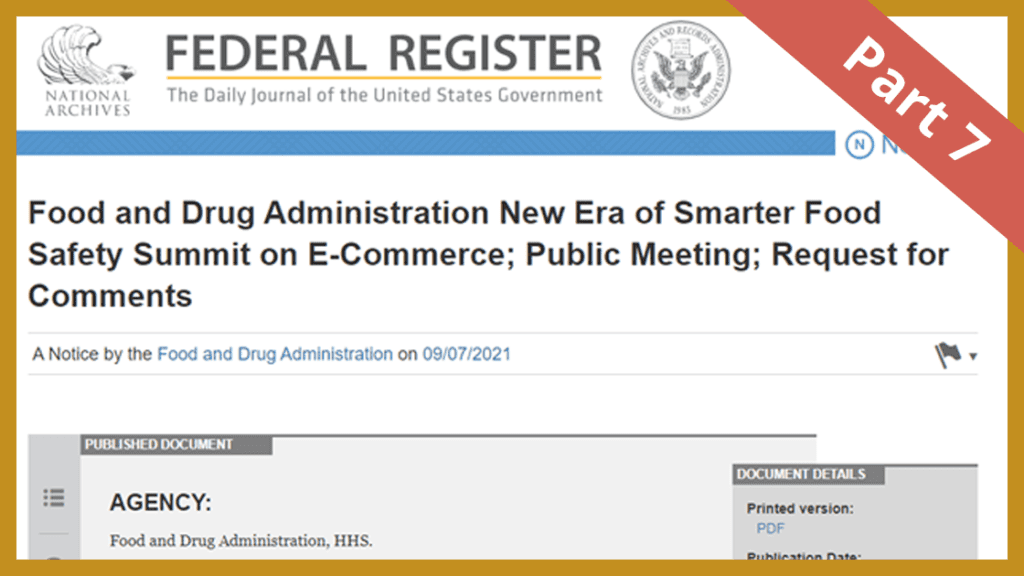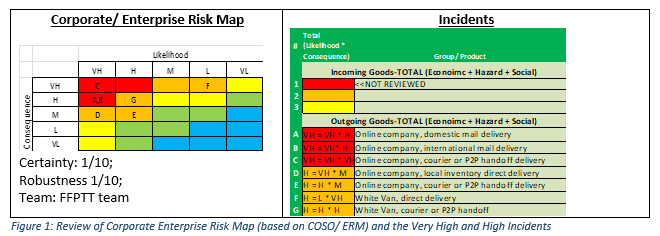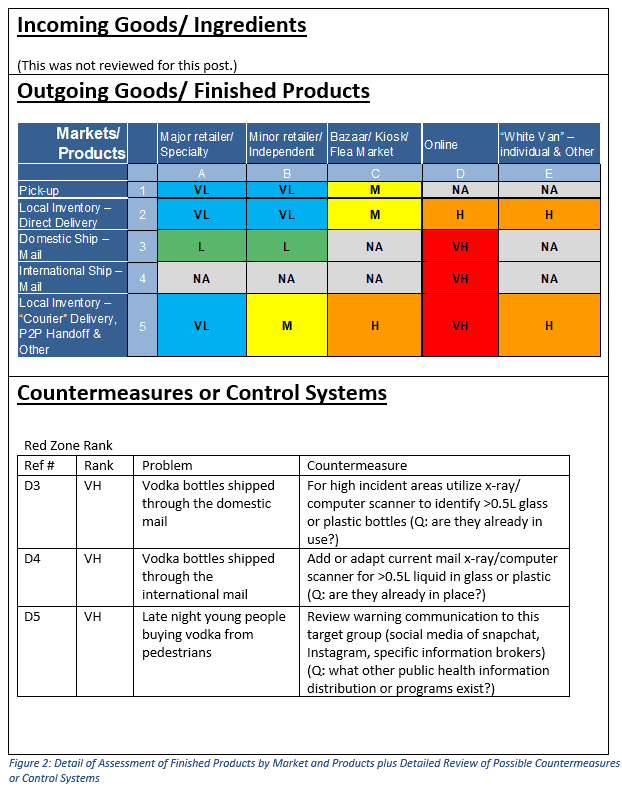Every food company has experienced the rapid evolution of e-commerce. While B2C e-commerce is a broad category, the FDA Public Meeting emphasizes “e.g., produce and meal kit subscription services, ghost kitchens, dark stores.” FDA also mentioned types of delivery models, “e.g., third-party delivery, autonomous delivery models.” This post will review the concepts in detail.
This is the seventh blog post in our multi-post series that focuses on the FDA “New Era of Smarter Food Safety” (SFS) blueprint. Other blog posts include a review of the FDA public meeting, an e-commerce and food fraud overview, a review of ISO cybersecurity definitions, a video lecture on cybersecurity and the food safety manager, an introduction to supply chain mapping and criminology hot spot analysis, definitions for “Produce and Meal Kit Subscription Services, Ghost Kitchens, Dark Stores”, and possibly others.
Are you wondering how to get started on a country- or company-level vulnerability assessment? An example is included here of a country-level assessment of counterfeit vodka. COSO/ enterprise risk management includes a first step that is an “initial screening.” The initial screening is conducted to provide a broad overview with often very little information.
This initial screening – or sometimes referred to as a “pre-filter” – example is provided since it is directly applicable to the problems stated during the FDA Food E-Commerce Public Meeting. A first step when reviewing a new or emerging problem is to gather enough information to conduct a vulnerability or risk assessment. When addressing a new or emerging topic, the traditional in-depth assessment methods are often too cumbersome or ill-fitting. Fortunately, there are methods and processes developed for these types of situations. Leveraging COSO/ Enterprise Risk Management, the two-tiered assessment approach includes first an initial screening to get an overview and then second a more detailed assessment to support decision-making.
The FDA Food E-Commerce challenge of conducting a first review is similar to the question that is addressed in our food fraud prevention research. In 2015 we published our peer-reviewed, scholarly journal article, “Introducing the Food Fraud Initial Screening Model (FFIS).”
- Spink, John, Moyer, Douglas C, & Speier-Pero, Cheri (2016). Introducing the Food Fraud Initial Screening Model (FFIS), Food Control, Volume 69, November 2016, Pages 306-314. URL: https://www.sciencedirect.com/science/article/abs/pii/S0956713516301219
To address a specific question about a country-level application, we developed the following case study that was presented to the 2016 Interpol Operation Opson meeting hosted by the Food Safety Authority of Ireland.
- Food Fraud Prevention Challenges in E-Commerce [FSAI] – e-commerce and country-level assessment: a presentation at the Food Safety Authority of Ireland meeting for the EU Food Integrity Project. This covers a Food Fraud Vulnerability Assessment (initial screening) for an entire country of a specific product problem. (18 minutes): https://www.youtube.com/watch?v=uhrkoUuOhEk
The detail of the example is provided:
Pre-Filter Food Fraud Initial Screening (FFIS) using Open-Source Information
For: COUNTRY/ Vodka
Date: Conducted October 6, 2017 (Published in Food Fraud Prevention, 2021[1])
Summary: An open-source search was conducted to review the Food Fraud vulnerability[2] for COUNTRY/ Vodka. The goal was to provide an example of the FFIS tool for a specific problem. The review assessment is ranked as certainty 1/10, robustness 1/10, and the team is the Food Fraud Prevention Think Tank team. The assessment identified three specific “Very High” and four specific “High” vulnerabilities. The likelihood was an estimate based on base awareness and local discussions. The consequence was a combination of the health hazard incidents, the loss of economic contribution from lost sales, and then a social factor of concern raised by an incident/ illness/ death by the specific retail location. E.g., it is more concerning for consumers if there is a slight problem at a trusted supplier rather than an incident at an informal or illicit market. The “Market” main concerns appeared to be (1) online marketplaces and (2) “white van” deliveries (an unofficial seller of product “out of the back of a ‘white van.’” The “Product” for an online sale is the delivery and the main concerns were (1) local courier or person-to-person delivery and (2) private or contract couriers.
Together three “Very High” problems were identified. Possible countermeasures or control systems were suggested for each:
- For high incident areas utilize x-ray/ computer system to identify >0.5L glass or plastic bottles
- Add or adapt current mail x-ray/computer scanner for >0.5L liquid in glass or plastic
- Review warning communication to this target group (social media of snapchat, Instagram, specific information brokers)
- Note: all three countermeasures or control systems may already be implemented by other agencies to achieve other objectives.
The next step is to review the assessments and increase the certainty and robustness to a level necessary to decide on countermeasures and control systems.
Method: The pre-filter Food Fraud Initial Screening method (FFIS[3]) is the first of the two-stage assessment for COSO/ Enterprise Risk Management (ERM).[4] The Initial Screening is conducted both as a Food Fraud Vulnerability Assessment starting point and to understand public information that could lead to litigation. The limits for likelihood, consequence, and corporate risk appetite were estimated.
[1] Spink, John W (2019). Food Fraud Prevention – Introduction, Implementation, and Management, Springer Publishing, New York, URL: https://www.foodfraudpreventionthinktank.com/bookstore/
[2] PWC (2016), Food Fraud Vulnerability Assessment, URL: https://www.pwchk.com/en/industries/food-supply-and-integrity/fighting-food-fraud.html
[3] Spink, Moyer & Speier-Pero (2015), Introducing the Food Fraud Initial Screening Tool (FFIS), Food Control, Volume 69, Pages 306-314, URL: http://www.sciencedirect.com/science/article/pii/S0956713516301219
[4] COSO (2016), ERM Risk Assessment in Practice, URL: https://www.coso.org/-ERM.htm
While the FDA Food E-Commerce Public Meeting addresses new business models and new risks, the underlying vulnerability and risk assessment can use current methods. The COSO/ ERM based concepts apply to companies and countries. Specifically, the COSO/ ERM based “initial screening” can be very efficiently applied to even a country-level assessment… as the example demonstrates. Once the highest vulnerabilities and risks are identified, then the focus can shift to considering risk treatments. The initial screening can quickly identify where there are areas of concern (or not). Don’t reinvent the wheel. Begin by considering current processes and methods. Later you can make minor adjustments as needed.



